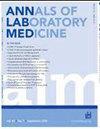变异对干扰素释放试验性能的影响:定量分析。
IF 3.9
2区 医学
Q1 MEDICAL LABORATORY TECHNOLOGY
引用次数: 0
摘要
干扰素γ释放试验(IGRAs)被广泛用于鉴定潜伏性结核感染(LTBI);然而,固有的测试可变性影响其诊断解释。我们使用统计模型评估了假阳性和假阴性率,以及cv中20%、40%、60%、80%和100%的转换和逆转率。在诊断截止值为0.35 IU/mL时,随着cv的增加,假阴性率从1.61%增加到33.41%,而在0.20-0.70 IU/mL的临界值范围内,假阳性率从0.00%增加到15.87%。将临界值扩大到0.20-1.00 IU/mL,在不影响假阴性的情况下,将假阳性率降低到最高3.16%。在0.20 ~ 0.70 IU/mL交界区,0.20和0.35 IU/mL的正确还原率和错误转化率分别为0.01% ~ 25.00%和0.00% ~ 24.20%。在0.35、0.70和1.00 IU/mL时,正确转化率为0.05% ~ 24.20%,错误转化率为0.00% ~ 25.00%。这些结果强调了在IGRA解释中采用边界区域以减少错误分类的重要性,尽管制造、分析前处理和分析程序的差异仍然是一个重大挑战。通过提高生产一致性、标准化样品处理和自动化分析平台来减少这种可变性,对于提高IGRAs诊断LTBI的可靠性至关重要。本文章由计算机程序翻译,如有差异,请以英文原文为准。
Effect of Variability on Interferon-Gamma Release Assay Performance: A Quantitative Analysis.
Interferon-gamma release assays (IGRAs) are widely used to identify latent tuberculosis infection (LTBI); however, inherent test variability affects their diagnostic interpretation. We evaluated false-positive and false-negative rates, as well as conversion and reversion rates across CVs of 20%, 40%, 60%, 80%, and 100%, using statistical modeling. At a diagnostic cutoff of 0.35 IU/mL, false-negative rates increased from 1.61% to 33.41% with increasing CVs, whereas false-positive rates ranged from 0.00% to 15.87% within the 0.20-0.70 IU/mL borderline range. Expanding the borderline to 0.20-1.00 IU/mL reduced false-positive rates to a maximum of 3.16%, without affecting false-negative rates. Within the 0.20-0.70 IU/mL borderline zone, correct reversion and false conversion rates at 0.20 and 0.35 IU/mL ranged from 0.01% to 25.00% and 0.00% to 24.20%, respectively. At 0.35, 0.70, and 1.00 IU/mL, correct conversion and false reversion rates ranged from 0.05% to 24.20% and 0.00% to 25.00%, respectively. These results highlight the importance of adopting borderline zones in IGRA interpretation to reduce misclassification, although variability from manufacturing, pre-analytical processing, and analytical procedures remains a significant challenge. Reducing such variability through improved production consistency, standardized sample handling, and automated analysis platforms is essential to enhance the diagnostic reliability of IGRAs for LTBI.
求助全文
通过发布文献求助,成功后即可免费获取论文全文。
去求助
来源期刊

Annals of Laboratory Medicine
MEDICAL LABORATORY TECHNOLOGY-
CiteScore
8.30
自引率
12.20%
发文量
100
审稿时长
6-12 weeks
期刊介绍:
Annals of Laboratory Medicine is the official journal of Korean Society for Laboratory Medicine. The journal title has been recently changed from the Korean Journal of Laboratory Medicine (ISSN, 1598-6535) from the January issue of 2012. The JCR 2017 Impact factor of Ann Lab Med was 1.916.
 求助内容:
求助内容: 应助结果提醒方式:
应助结果提醒方式:


